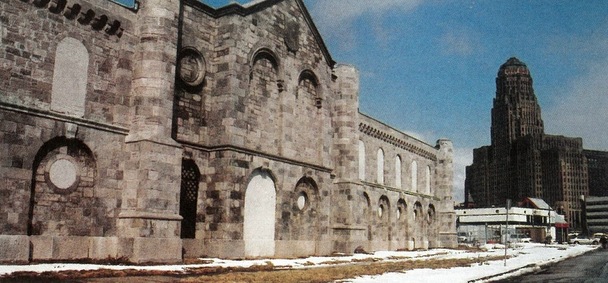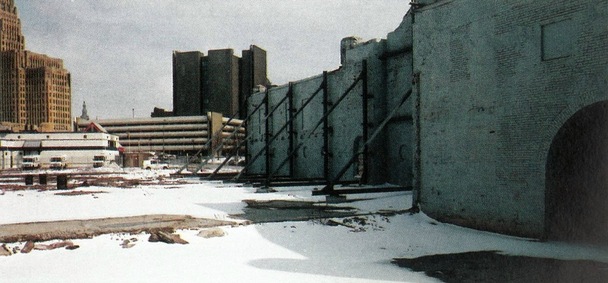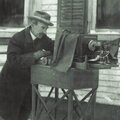
Buffalo Gas Works façade, West Genesee Street, with City Hall in background.
Photo by Paul F. Redding
Alone at the foot of West Genesee Street stands one of the earliest surviving pieces of industrial architecture along the Buffalo waterfront. Looking more like it belongs on the set of a Hollywood movie, the remaining facade of the Buffalo Gas Works with its steel bracing may soon be joining the ranks of endangered Buffalo architecture.
The Buffalo Gas Light Company was founded in 1848, with E.G. Spaulding as its first president, and first illuminated the streets of Buffalo in November 1848. The three-acre lake-front plot was chosen for reasons of safety and closeness to rail and canal transportation. By 1859, new construction was underway at the site. The new structures included a coal shed, several large processing-related buildings, two iron gasometers and a retort house. The stone façade of the retort house is all that remains of this National Register-listed complex.
The imposing main building was designed in the Norman Romanesque style by the important local architect John H. Selkirk. The prominent 250-foot long structure on Genesee Street soon became one of the most noteworthy industrial buildings in Buffalo. With its dressed stone façade, turrets and other commanding features, the castle-like building has been mistaken for an armory.
The illuminating gas was manufactured here by coking coal in a horizontal furnace. The coal gas given off in the process was collected and stored in two large gasometers, large expanding cylinders of sheet metal which could rise and descend within frames of structural iron to accommodate the gas within. The gas was then piped to street lamps.
During the 1890s, Buffalo Light Gas Company began producing Pintsch gas in its “Pintsch Works," a building erected near the main gate of the site. Pintsch gas is a highly compressed, high candle power illuminating gas. This gas was piped through a thick iron main lines to the nearby railroad yards where it was used to illuminate the passenger cars of the New York Central, Erie and Lehigh Valley railroads.

The Hollywood movie set type bracing holding up the façade of the Buffalo Gas Works.
Photo by Paul F. Redding
In 1899, Buffalo Gas Light Company merged with several other independent gas manufacturers to form the Buffalo Gas Company. Iroquois Gas Corporation obtained the property, including the Genesee Street gas works, in 1923. The 1859 plant was still being used by National Fuel Gas, successor to Iroquois Gas, into the 1990s.
In November 2000, this site became the focus of a plan for a hockey center by Dominik Hasek, the former Buffalo Sabres goalie. Soon after, the remaining buildings of the historic complex were demolished except for the stone façade, which was to be incorporated into the new structure. The project was to create a permanent home for a program Hasek co-founded in 1996 called the Dominik Hasek/Variety Club Youth Hockey League. In 2000, the League was teaching hockey to over 100 children from needy families.
The proposal for a two-rink center was met with great enthusiasm by hockey and skating supporters seeking more ice time in an area where skating rinks are much sought-after facilities. Hasek had pledged a million dollars to help get the project underway.
After Hasek was traded to Detroit by the Buffalo Sabres, the Youth Hockey League proposal was quietly abandoned. Recently, a plan was announced to build a new hockey and skating arena in Lancaster, at a cost of $35 million.
According to a spokesman for National Fuel Gas, owners of the Genesee Street property, “There are currently no plans for development of this property.” And so the commanding presence of the façade stands alone as a symbol of Buffalo’s ravaged industrial might, waiting silently for an adaptive reuse to bring it back to life.









